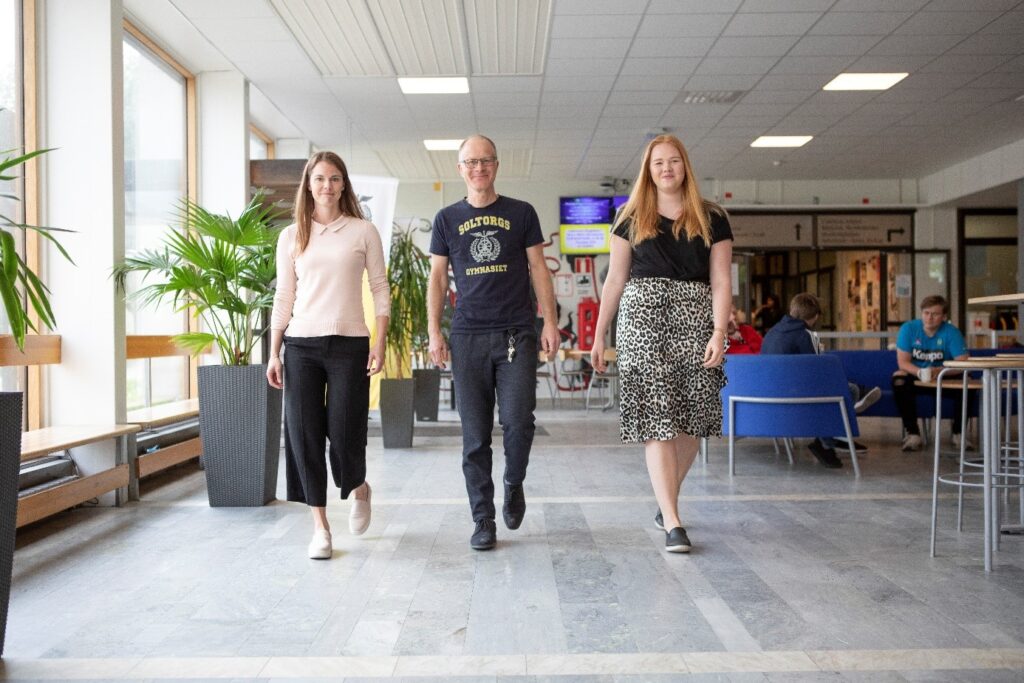Untidy toilets, poor environment in showers and changing rooms and generally a high level of noise characterize the indoor school environment for many school students. Students´ wellbeing is a prerequisite for being able to learn and perform in school and it is therefore important that pupils are allowed to participate in developing the quality of the school environment.
The students are the ones who first and foremost suffer from poor school premises. Therefore, it is important to bring the students into the work of creating the best possible conditions. Here, student safety representatives can play an important role. They act as a link between the other students and the school’s management.
At Soltorgsgymnasiet in Borlänge we meet principal Hans Carlson, assistant principal Anita Brandt and the student Emilia Malm, who in a couple of weeks finish her three-year program. Since the second year in high school, she has served as a student protection officer at the school together with Linn Svärd.
Emilia Malm:
– I was elected through the school’s student council and had to attend a training organized by Sweden’s student associations. At the student council meetings, which are conducted once a month, I receive input from the other students and at the same time I tell them what has been said at the collaboration meetings and the annual safety round. At local collaboration meetings, which take place every month, school management, safety representatives, student safety representatives and union representatives participate.
At Soltorgsgymnasiet, the sports hall Maserhallen is used for the school’s physical education. For a long time, there have been problems with the environment in changing rooms and showers, which has been up for discussion both at the student council and at the collaboration meeting. Emilia continues:
– In Maserhallen, there are no shielding´s between showers, and mirrors and the ventilation is poor. Many students do not shower after the P E lessons.
Principal Hans Carlsson:
– At the school, Anita has meetings once a month with the student council and between the meetings the classes have class councils. It is very important for the students to be involved influencing the indoor environment.
Emilia Malm:
– The furniture in the foyer has also recently been up for discussion where we agreed on new furnishing.
One outcome is that decisions have recently been taken by the municipality to invest SEK 32 million in new ventilation in the sports hall, improved entrance, new hygiene facilities, changing rooms and energy systems.
Anita Brandt emphasizes that some things are repeatedly addressed by the students:
– It is really hot during parts of the year in some parts of the school. Also, there is high noise level outside some classrooms. We now have a document called “Error reporting”, where both students and staff can note problems that are then passed on to the property manager.
Principal Hans Carlsson says the school, in addition to student councils, also has a student union that primarily focuses on social activities and, among other things, arranges film nights and discussion forums.
The Work Environment Act and the Swedish Student Council
All schools should, according to the Work Environment Act, have several student safety representatives and the school boards should encourage students to appoint representatives. Principals are therefore urged to ensure that there are trained student safety representatives at each school and that they receive the training needed for the role.
The Swedish Student Council educates student safety representatives on how to work with both the physical and the psychosocial work environment, and how students can cooperate with school management. Without the students’ perspective, it is easy to miss problems.
Survey
The County Administrative Board, together with Sweden’s student associations, have conducted a survey looking at how the pupils’ safety representatives work.
There are 40 upper secondary schools and about 50 high schools in Dalarna. Of these, only 20 schools have trained a Student Safety Officer.
Conclusions of survey
A survey conducted among these 20 shows that the students participate in the systematic work environment collaboration in 75% of these schools. The students participate in the staff’s safety rounds and in the student council’s activities. In some upper secondary schools, the student protection officers work independently, on their own initiative, with work environment issues. The school management perceive that the communication with the student protection officers works well and that the problems that the student safety delegates point out are taken care of. Among positive experiences, it is emphasized that it facilitates dialogue with pupils, contributes to joint responsibility for the work environment and that many small things are addressed more quickly.
Almost every school has problems with indoor temperatures and poor air. Other common problems identified in the safety rounds are in descending order: broken things and littering, the environment in toilets / showers / changing rooms, lighting, and noise. Half of the schools show concrete examples where the student protection officers helped to make improvements, such as paper bins, earplugs, seating in the corridors, parking lots etc. They have also been instrumental in getting lighting replaced and getting access card systems for increased security.
New research shows the importance of the indoor environment.
Many studies show that light has direct effects on mood, alertness and attention. The lighting often consists of fluorescent lamps in the ceiling and lack of daylight inlets. The right lighting that can also be adjusted based on the type of activity benefits pupils’ learning, especially children with ADHD.
Danish research shows that poor air quality and indoor temperature can lead to as much as 30% lower level of performance among pupils in schools. But the solution is not just ventilating more, because then the humidity becomes too low which causes problems with dry mucous membranes and skin irritations.
Moisture and mold damage in buildings increases the risk of respiratory problems and asthma by 30-50% and the proportion of children with asthma increases.
It is also important to keep track of the level of particles in the air. There are no guidelines for particles in indoor air, only for larger particles of outdoor air. Small particles are carriers of bacilli and viruses and are also difficult for allergy sufferers. So, with particle cleaning more people would be healthy.
Poor sound environment is not only a problem for those with hearing loss, it affects learning for everyone, but it is especially important for students with a different mother tongue than Swedish.
Text authors: Hans Ahlin, Marit Ragnarsson, EFFECT4buildings













